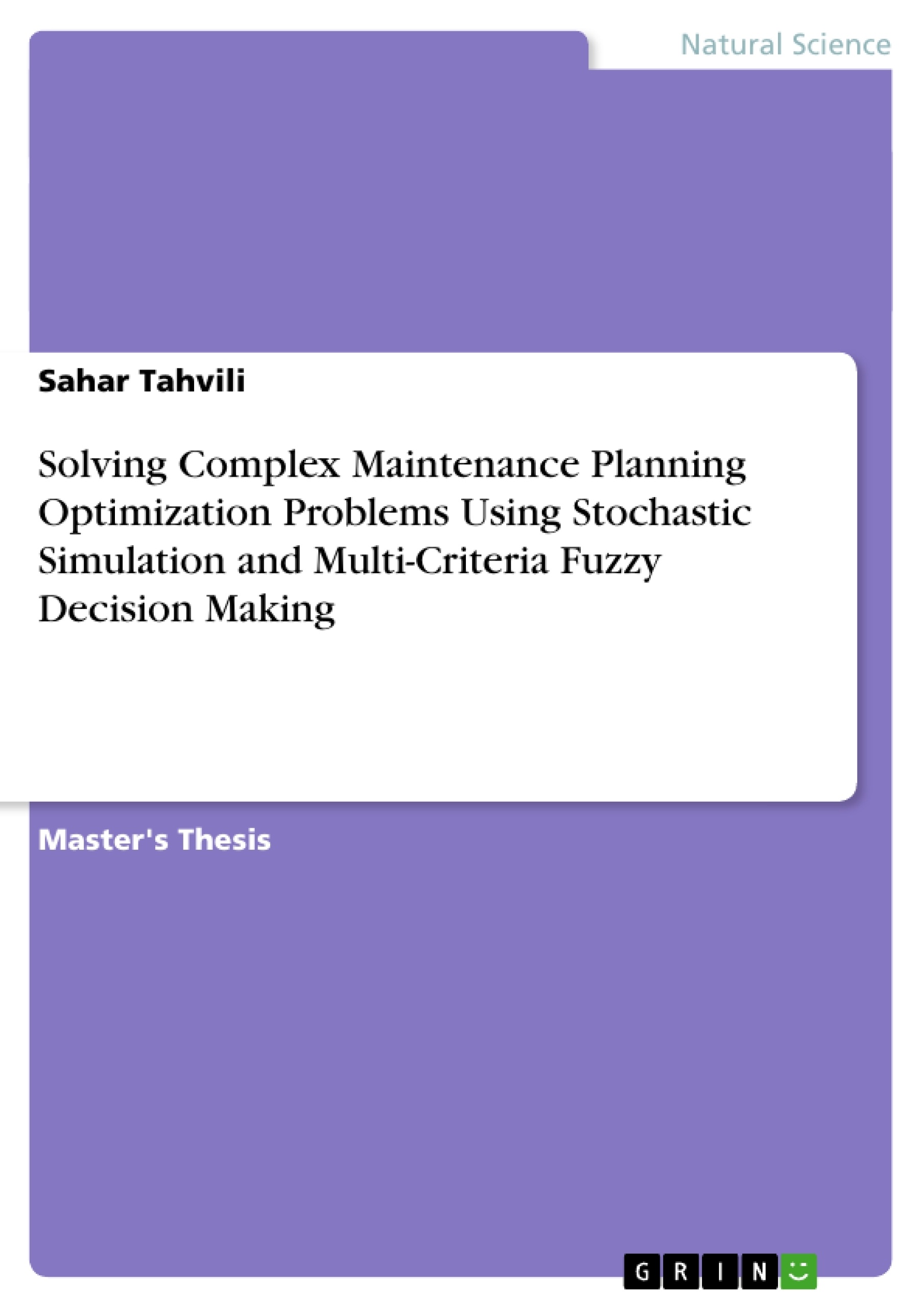The main goal of this project is to explore the use of stochastic simulation, genetic algorithms, fuzzy decision making and other tools for solving complex maintenance planning optimization problems. We use two different maintenance activities, corrective maintenance and preventive maintenance. Since the evaluation of specifc candidate maintenance policies can take a long time to execute and the problem of finding the optimal policy is both non-linear and non-convex, we propose the use of genetic algorithms (GA) for the optimization. The main task of the GA is to find the optimal maintenance policy, which involves: (1) the probability of breakdown, (2) calculation of the cost of corrective maintenance, (3) calculation of the cost of preventive maintenance and (4) calculation of ROI (Return On Investment). Another goal of this project is to create a decision making model for multi-criteria systems. To find a near-optimal maintenance policy, we need to have an overview over the health status of the system components. To model the health of a component we should find all the operational criteria that affect it. We also need to analyze alternative maintenance activities in order to make the best maintenance decisions. In order to do that, the TOPSIS method and fuzzy decision making has been used. To evaluate the proposed methodology, internal combustion engine cooling of a typical Scania truck was used as a case study.
Frequently asked questions
What is the main topic of this document?
This document is a Master Thesis in Mathematics/Applied Mathematics, focusing on solving complex maintenance planning optimization problems using stochastic simulation and multi-criteria fuzzy decision making.
Who is the author of this thesis?
The author of the thesis is Sahar Tahvili.
What are some keywords associated with this research?
Keywords include Genetic algorithm, Corrective maintenance, Preventive maintenance, ROI, Multi-criteria decision making, TOPSIS, Fuzzy decision making, Discrete event simulation, and Intelligent agent.
What are the two main maintenance activities discussed?
The thesis focuses on two main maintenance activities: Corrective Maintenance (CM) and Preventive Maintenance (PM).
What are the methods employed to solve the maintenance planning problem?
The research employs stochastic simulation, genetic algorithms, fuzzy decision making, and the TOPSIS method.
What are the key components considered in the life cycle cost (LCC) analysis?
The LCC is divided into: initial cost, installation cost, energy cost, operation cost, maintenance and repair cost, downtime cost, environmental cost, and decommissioning and disposal cost.
What is the formula used to calculate Return on Investment (ROI) in this context?
The ROI is calculated by ROI = (Return - Investment) / Investment, or, more specifically for maintenance, ROIm = (CH - CHM) / IHM, where CH is the life-cycle cost of unscheduled maintenance, CHM is the life-cycle cost of health management, and IHM is the investment in health management.
What are the three replacement strategies mentioned?
The three replacement strategies mentioned are minimal repair, imperfect reparation, and perfect reparation.
What is the "bathtub curve" hazard function mentioned in Component Health section?
The bathtub curve illustrates the hazard function over time, typically including three phases: failures phase (decreasing failure rate), phase with constant (random) failure rate, and wear-out failures phase (increasing failure rate).
What is the purpose of using fuzzy logic and TOPSIS in the decision-making process?
Fuzzy logic and TOPSIS are used to model uncertainty and prioritize maintenance alternatives based on multiple criteria, considering both the "ideal" and "worst-case" scenarios.
What was used as a case study for evaluating the proposed methodology?
The internal combustion engine cooling of a typical Scania truck was used as a case study to evaluate the proposed methodology.
What is a "decidor" and how it's used in the simulation?
A "decidor" is a component in the simulation framework that determines whether a plannable event should be triggered, based on the current system state and a predefined decision logic.
What is Riccati differential equation in this context?
The Riccati differential equation is used in Chapter 2 to model dynamic reliability equation.
What are some of the variables that the study takes into consideration?
Variable are Genetic algorithm, Corrective maintenance, Preventive maintenance, ROI, Multi-criteria decision making, TOPSIS, Fuzzy decision making, Discrete event simulation, and Intelligent agent.
- Citation du texte
- Sahar Tahvili (Auteur), 2014, Solving Complex Maintenance Planning Optimization Problems Using Stochastic Simulation and Multi-Criteria Fuzzy Decision Making, Munich, GRIN Verlag, https://www.grin.com/document/281688




